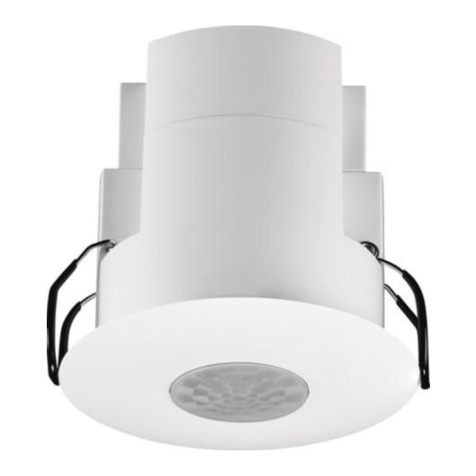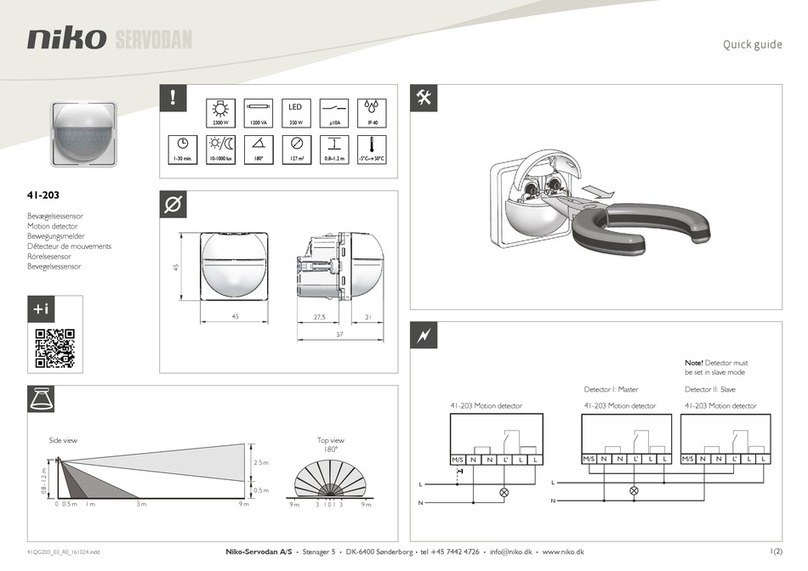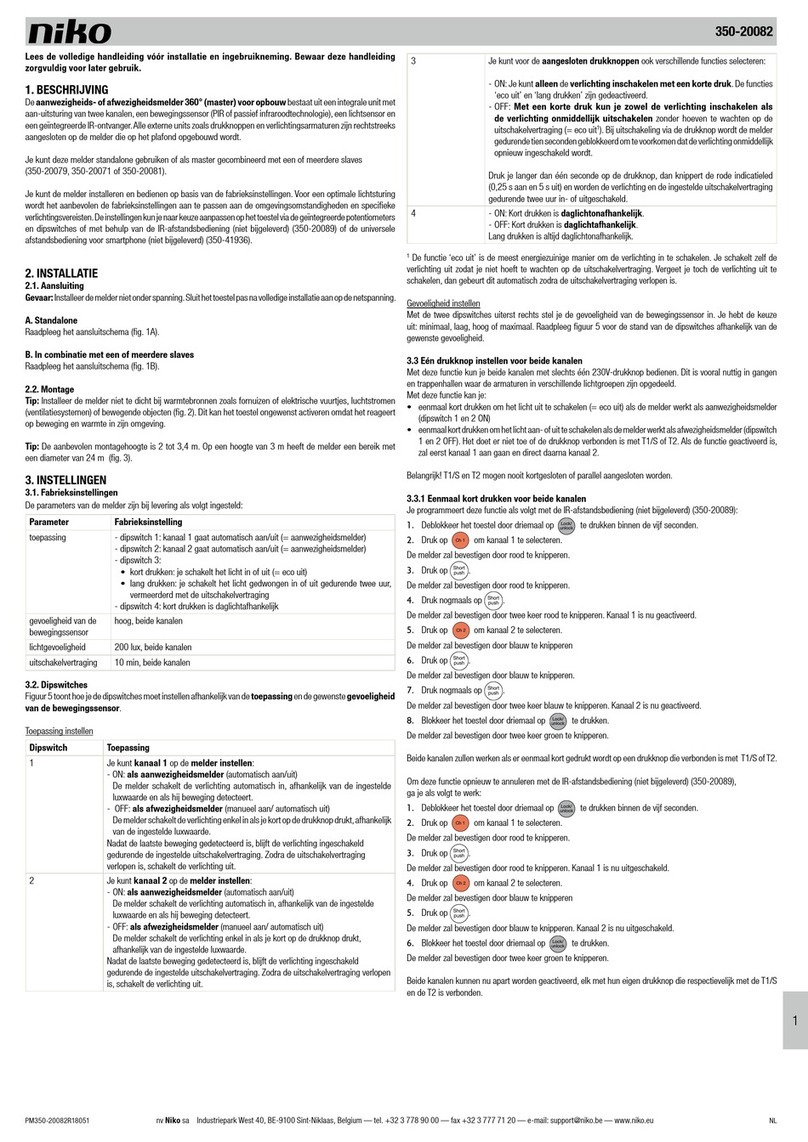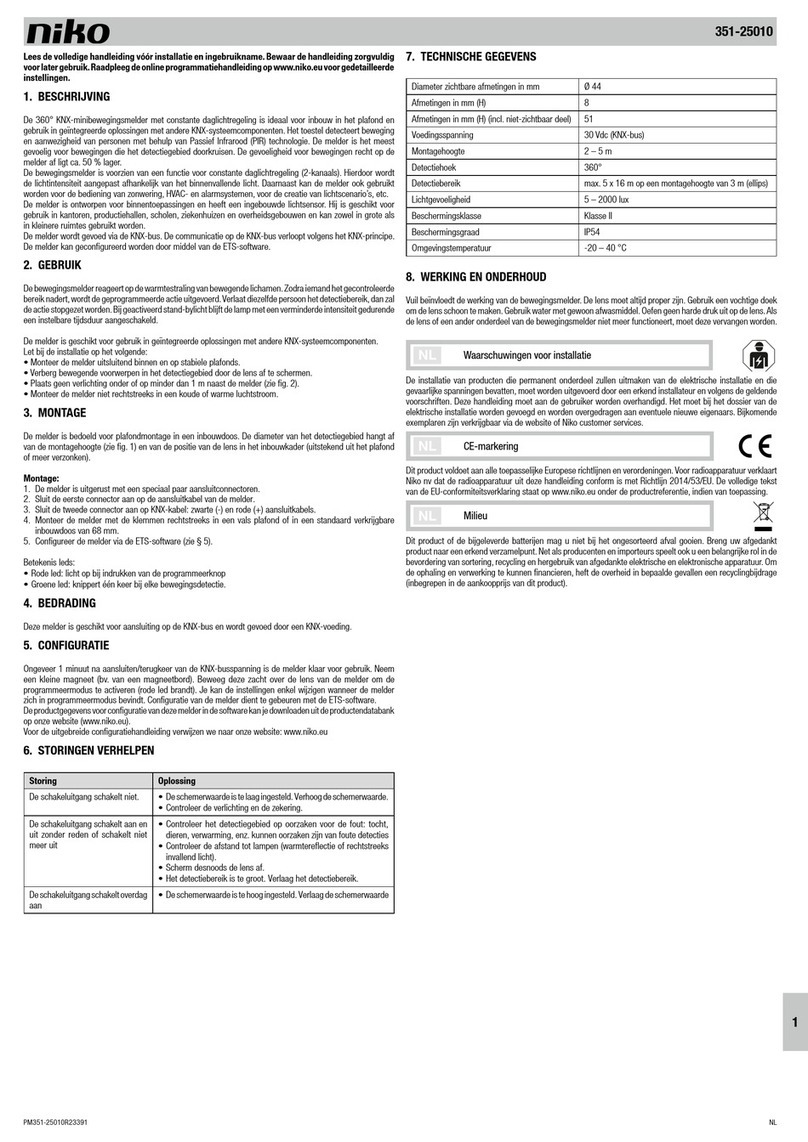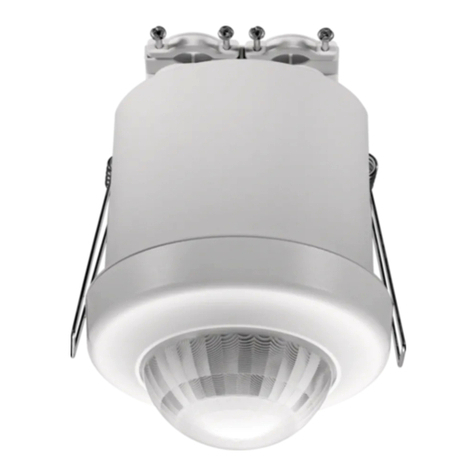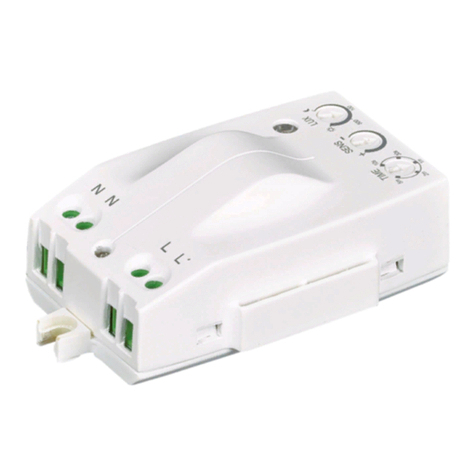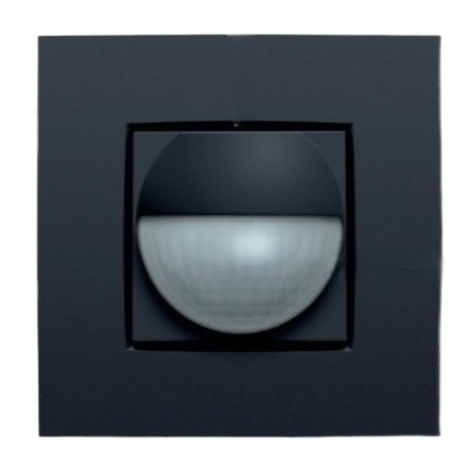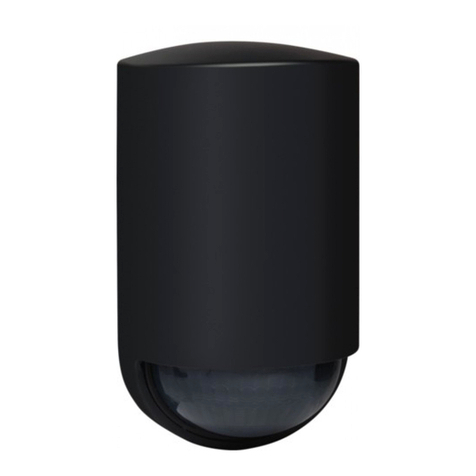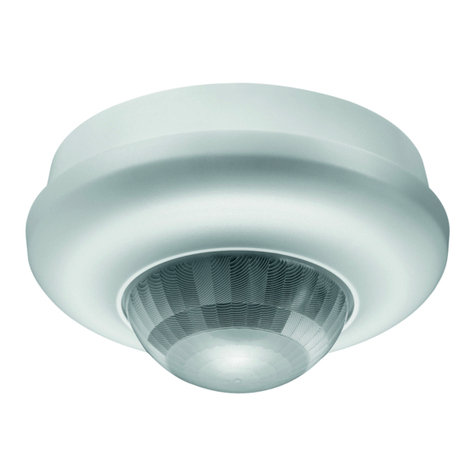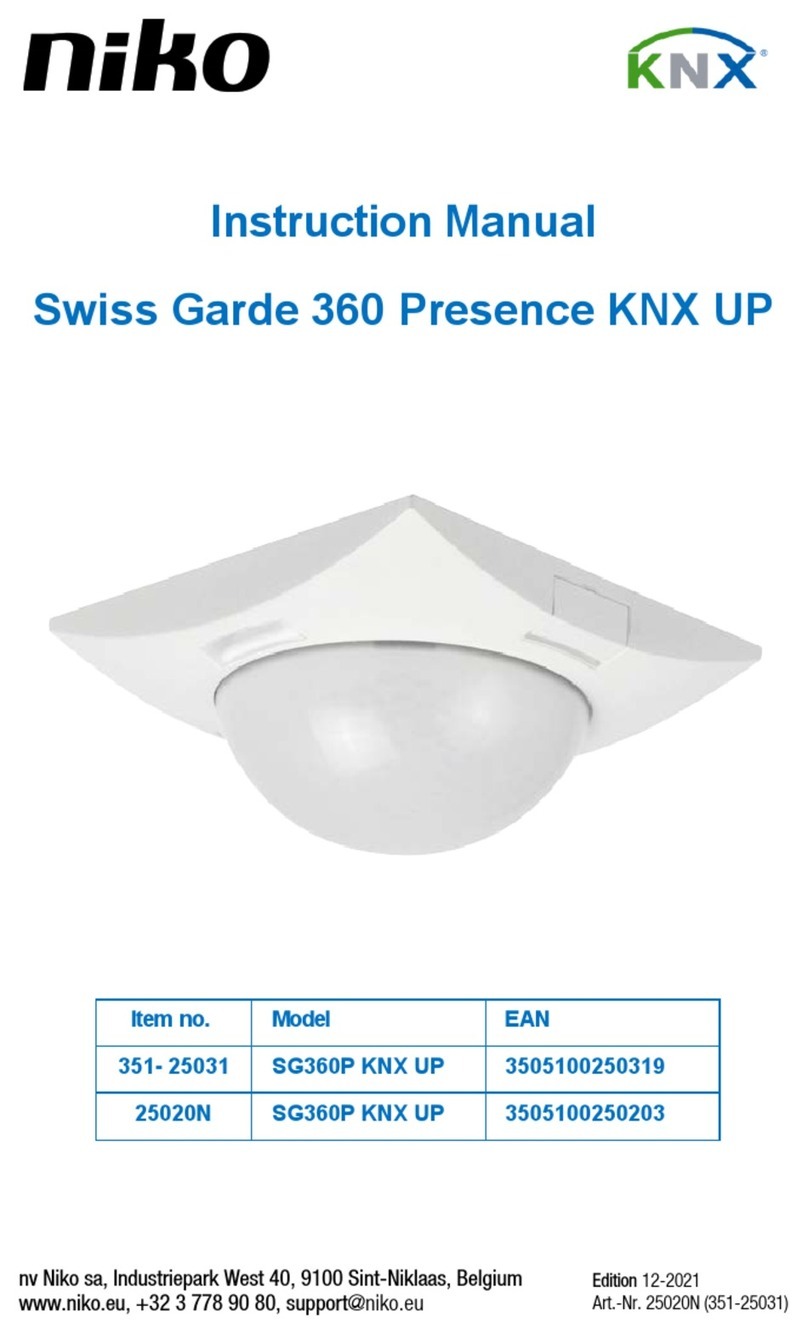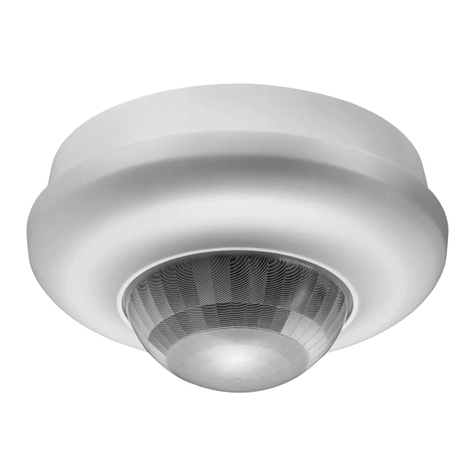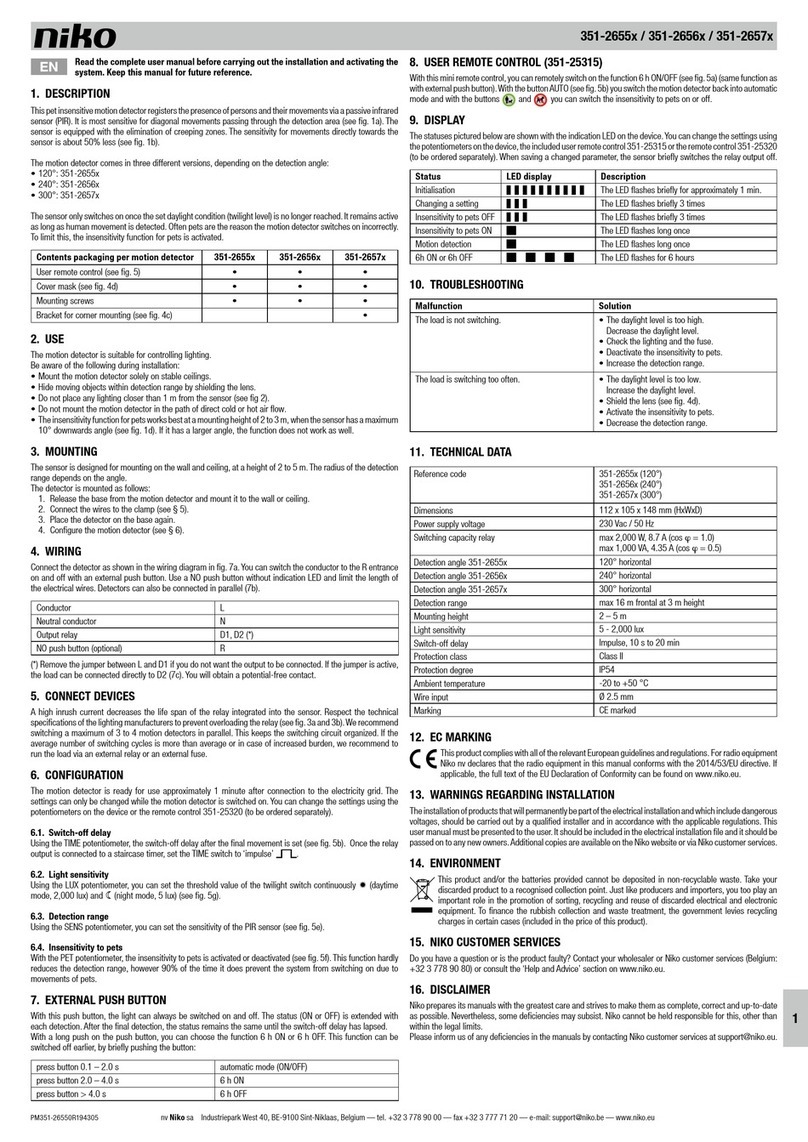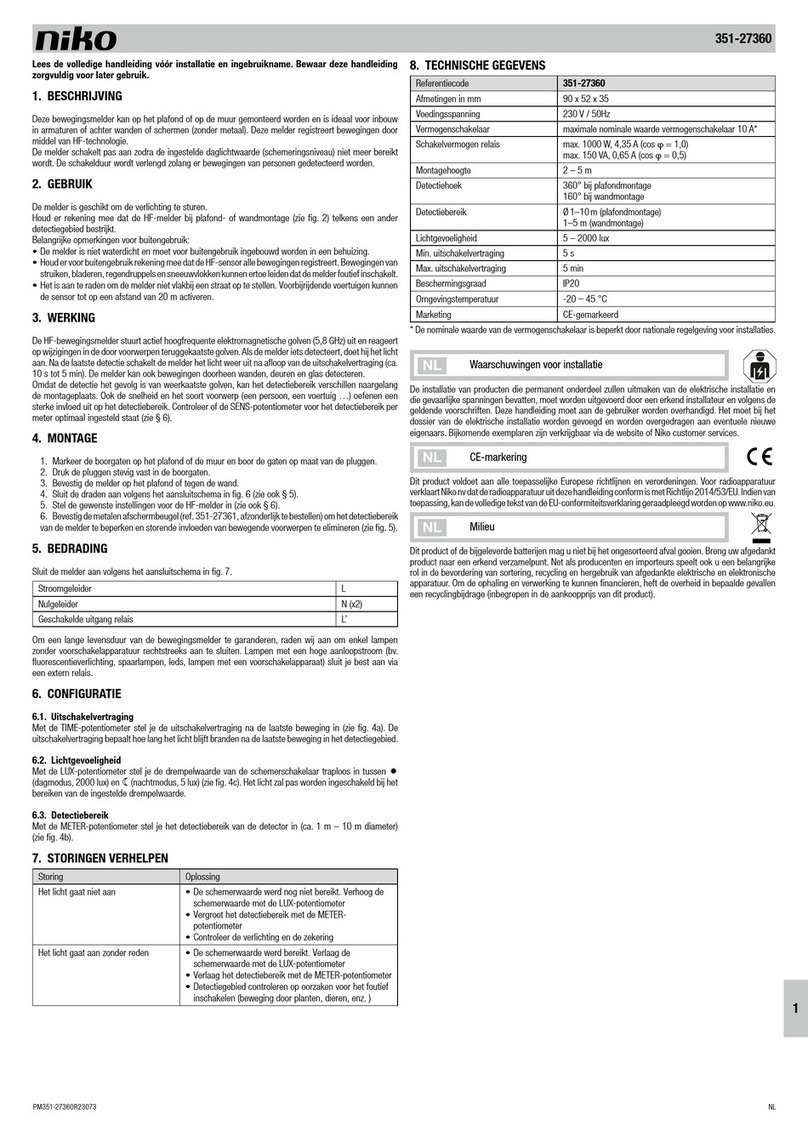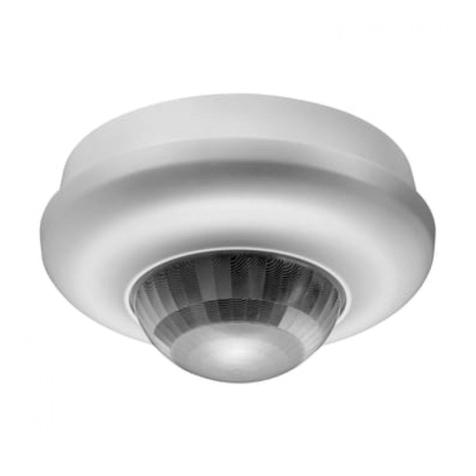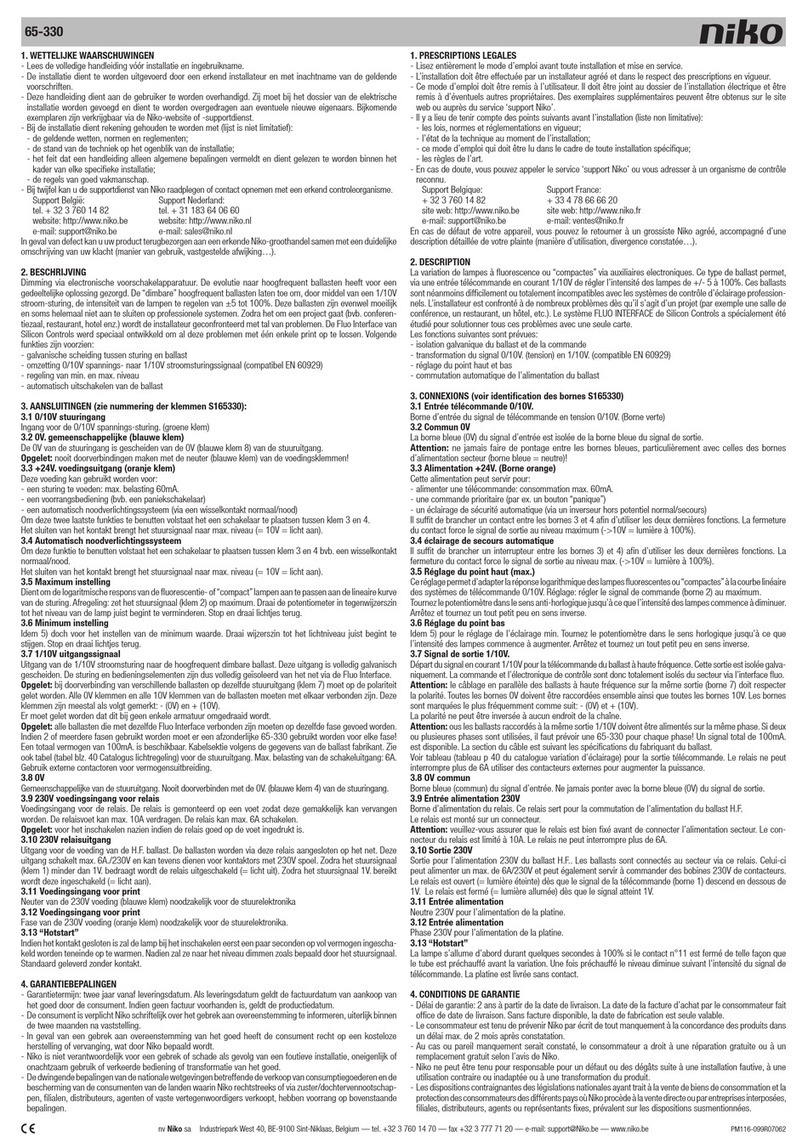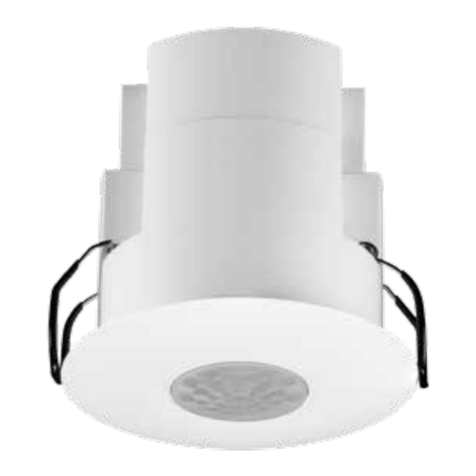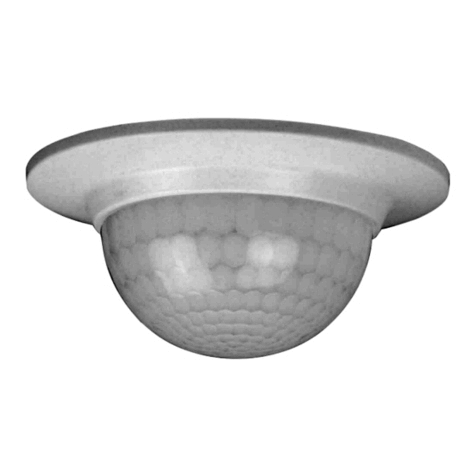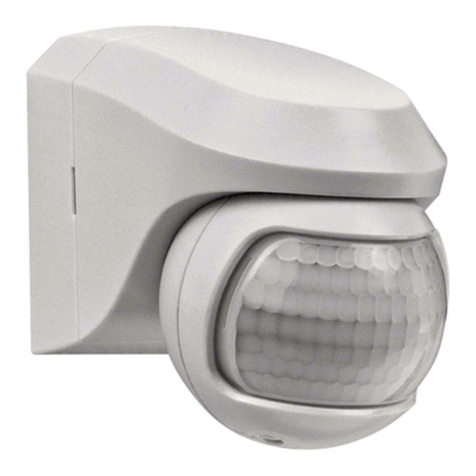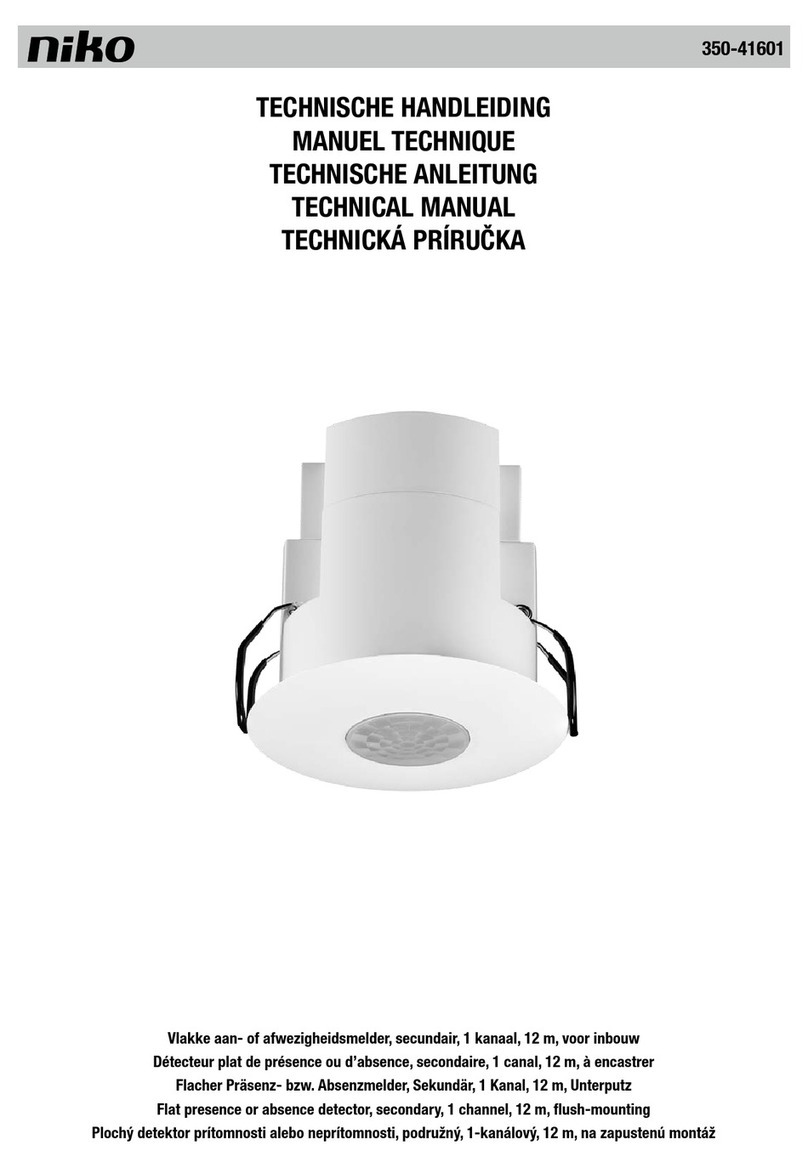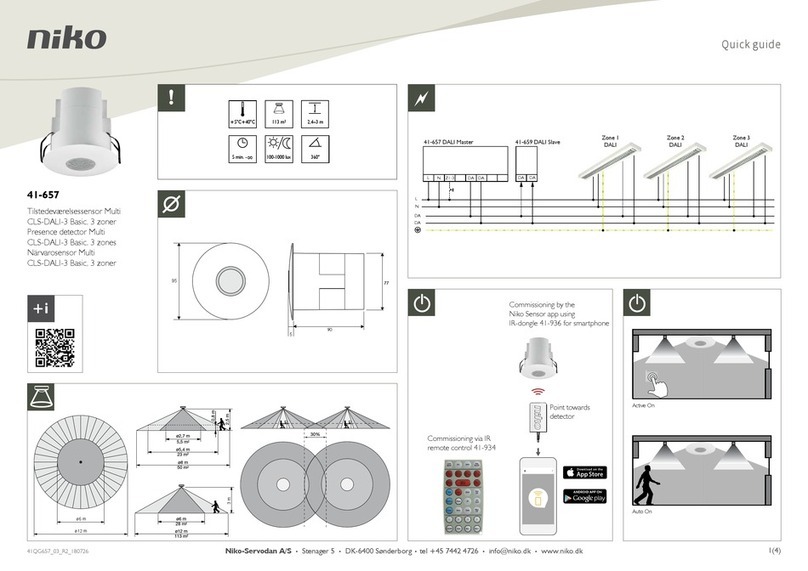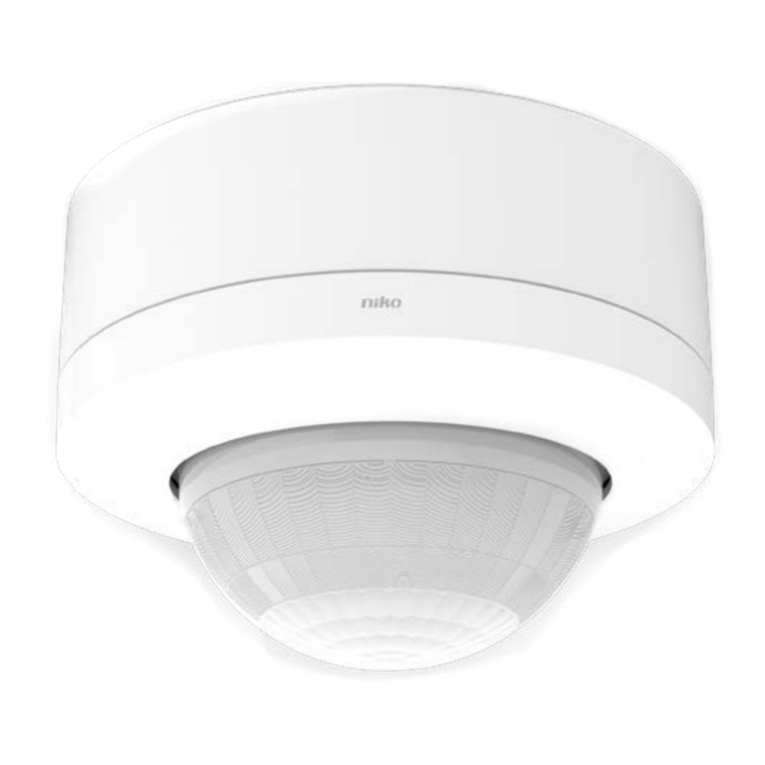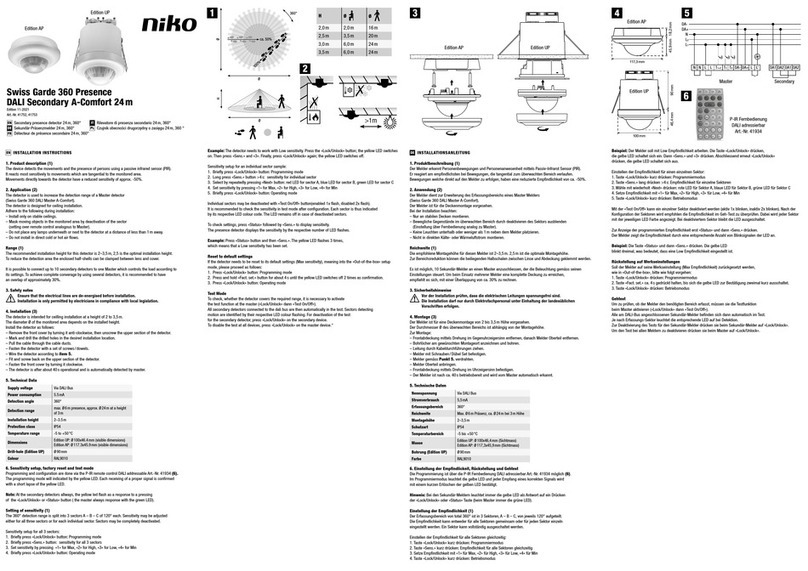
21 3 4
7
L
L’
S R N
7a
3a
max. 1000VA cos ϕ= 0,5
3b230V AC DC
❆
x
❄
❆
z
Time
Mode
Lux
4a
2a 2b 2c
4b
Master
detector
Secondary
detector
4c
7b
L
L’
S R N
Master
LSRN
Secondary
LS R N
Secondary
176°
R
100%
ca. 50%
Presence detector 8m, 180°
Präsenzmelder 8 m, 180°
Détecteur de présence 8m, 180°
Rilevatore di presenza 8m, 180°
Czujnik obecności o zasięgu 8m, 180°
DE
FR
IT
EN
PL
Swiss Garde 180 Presence
master / secondary detector UP
Edition 12-2021
Art.-Nr. 25380CH, 24380CH, 25382CH, 24386CH
Edition
CH
6
60 mm
88 mm
12.7 mm
5
H = 0,9–1,3
H
BRBR
1m 5 m 8m 3m 4,5 m
FR NOTICE D’INSTALLATION
1. Description du produit (1)
Le détecteur perçoit les mouvements et donc la présence de personnes par l’intermédiaire d’un système à capteur
infrarouge passif (PIR). La réaction de celui-ci est la plus sensible lorsque le mouvement est tangentiel au cercle formé
par la zone surveillée. L’appareil est moins sensible, env. 50% de moins, lorsque le déplacement se fait en direction du
détecteur. Le détecteur maître ne réagit que si la valeur de luminosité qu’il mesure est sous la consigne réglée (seuil
crépusculaire en lux). La durée d’allumage est prolongée tant que des mouvements sont détectés dans l’ensemble
de la zone de détection ou tant que des personnes sont considérées présentes dans la zone dite de présence. Le
détecteur maître perçoit l’augmentation de la luminosité environnante après commutation et coupe l’alimentation de
la charge en cas de luminosité suffisante. Le détecteur secondaire ne peut commuter aucune charge et est seulement
utilisé pour augmenter la portée de détection du détecteur maître. Les éléments mentionnés en tant qu’accessoires
ne font pas partie de la livraison.
2. Utilisation
Le détecteur est adapté à un usage intérieur pour la commande de luminaires.
Tenir compte des points suivants lors de l’installation :
– Ne monter que sur des supports stables.
– Utiliser les caches ou du ruban adhésif sur la lentille pour limiter la zone
de surveillance ou masquer les sources de détection non désirées.
– Ne pas mettre de luminaire sous le détecteur ou à moins
d’un mètre à côté du détecteur (2a).
– Ne pas installer directement dans les courants d’air froids (2b) ou chauds (2c).
3. Consignes de sécurité
!
Avant l’installation, vérifier la mise hors tension des câbles.
L’installation doit exclusivement être effectuée par des électriciens
spécialisés dans le respect des normes nationales.
4. Installation
Le détecteur est prévu pour un montage au mur à une hauteur de 0,9 à 1,3m. Placez le détecteur maître dans une
zone avec influence moyenne de la lumière ambiente dans les applications maîtres/secondaires.
Pour le montage :
– Déposer l’enjoliveur du détecteur.
– Pour retirer le poussoir, insérer un tournevis dans la fente latérale et faire levier (4a).
– Câbler le détecteur selon paragraphe 5.
– Fixer le détecteur sur la boite d’encastrement.
– Effectuer la configuration selon paragraphe 7.
– Reposer l’enjoliveur du détecteur.
5. Raccordement (7a–7b)
Le circuit électrique doit être protégé par un dispositif respectant les normes en vigueur. Le bouton poussoir optionnel
externe envoie la phase sur l’entrée R. Utiliser impérativement un poussoir sans lampe témoin et faire le câblage de
ce poussoir au plus court. Au lieu d’un poussoir externe, nous conseillons d’utiliser un détecteur secondaire. Le fait de
relier toutes les bornes R ensemble permet l’allumage à partir de chaque détecteur. De plus, le détecteur secondaire
augmente la zone de détection. L’entrée S du détecteur maître accepte jusqu’à 10 détecteurs secondaires, le câblage
doit être au plus court.
Détecteur maître Détecteur secondaire
Phase L L
Neutre N N
Sortie relais L’ –
Maître - Entrée poussoir optionnel externe R –
Détecteur secondaire - Entrée poussoir optionnel externe R R
Détecteur secondaire - Détection optionnelle S S
6. Raccordement de la charge
Des courants d’appel élevés réduisent la durée de vie du relais intégré dans le détecteur. Tenir compte des indications
techniques du fabricant de luminaires et d’ampoules, pour que le relais ne soit pas soumis à une surcharge (3a–3b).
Pour une configuration optimale du circuit, nous recommandons de monter en parallèle au maximum 3–4 détecteurs.
En cas de cycles de commutation particulièrement fréquents ou en cas de charges élevées, nous recommandons de
commuter la charge au travers d’un relais externe ou d’une minuterie.
7. Configuration (4b)
Le détecteur est fonctionnel env. 1 min après la mise sous tension. La modification des paramètres doit se faire en
service : les réglages sont effectués directement sur le corps du détecteur ou via la télécommande disponible en
accessoire.
Temporisation : TIME ; détermine la durée après le dernier mouvement. Si le détecteur actionne une minuterie, il
faut régler le paramètre TIME sur impulsion ( ).
Seuil crépusculaire : LUX ; détermine le seuil crépusculaire sous lequel,
entre le jour (2000lx) et la nuit (5 lx), le détecteur est actif.
Fonctionnalité : MODE détermine le mode de fonctionnement du détecteur qui est indiqué à chaque changement
pendant 3s :
Automatique ➡ Voyant LED vert
Couloir ➡ Voyant LED vert/orange
Semi-Automatique ➡ Voyant LED orange
Remarque : Dans le mode couloir, un appui sur le poussoir intégré ou externe provoque uniquement l’allumage,
l’extinction manuelle est impossible. Dans le mode semi-automatique, l’allumage n’est possible que par appui sur le
poussoir intégré ou externe. L’extinction est manuelle ou automatique. Le détecteur est encore actif durant 5 s après
coupure automatique et peut alors allumer à nouveau en cas de détection.
8. Commande externe intégré
La lumière peut être allumée ou éteinte manuellement à tout moment.
L’état, ON ou OFF, est prolongé à chaque détection. En mode couloir seul l’allumage est possible manuellement. Apres
la dernière détection, l’état est encore maintenu pendant la durée réglée. Un appui long sur le bouton poussoir amène
le détecteur dans un état ON ou OFF prolongé de 6h.L’état prolongé de 6h, ON ou OFF, est désactivé après un appui
bref sur le bouton poussoir :
Appui Auto Couloir Semi-Auto
0,1–2s ON/OFF ON ON/ OFF
2,0–4s 6h ON –6h ON
>4,0s 6h OFF – –
9. Affichage
Les états suivants sont indiqués par le comportement de la LED. Les paramètres peuvent être modifiés sur le
corps du détecteur ou via la télécommande (accessoire). Lorsqu’une modification de paramètre est enregistrée, le
détecteur désactive brièvement la sortie du relais.
Etat Rouge Vert Orange Affichage
Démarrage détecteur maître/secondaire env. 1 min clignotement bref
Détection ou signal du détecteur se-
condaire 1x clignotement long
6h ON/6 h OFF 6h clignotement long
Mode changement Auto 3x clignotement long
Mode changement Couloir 3x clignotement alterné
Mode changement Semi-Auto 3x clignotement long
Actif après coupure automatique Allumé 5s
Ordre de la télécommande 3x clignotement bref
Action poussoir sur détecteur maître 1x clignotement long
Action poussoir sur détecteur secondaire 1x clignotement long
10. Données techniques
Détecteur maître Détecteur secondaire
Alimentation 230V / 50 Hz
Pouvoir de coupure
du relais
2000W / 8,7A charge ohmique
1000VA/ 4,35A charge inductive
350W LED
–
Angle de détection 176°
Portée de détection max. rayon 4,5m en présence, max. rayon 8m à 1,3 m de hauteur
Réglage crépusculaire 5–2000lx –
Minuterie , 10s à 20 min –
Indice de protection IP20
Température d'utilisation -10 à +45°C
Dimensions (L x l x H) Edition CH: 88x88x12,7mm; Edition EU: 80x80x12,7mm
IT ISTRUZIONI PER L’INSTALLAZIONE
1. Descrizione del prodotto (1)
Il rivelatore di presenza rileva i movimenti e la presenza di persone utilizzando un sensore infrarosso passivo (PIR).
Esso reagisce sensibilmente ai movimenti tangenziali rispetto la zona monitorata. Movimenti diretti verso il sensore
vengono rilevati con una sensibilità ridotta di circa -50%. Il rivelatore si attiva solo quando viene raggiunto il valore di
luminosità impostato (soglia crepuscolare). Il tempo di accensione si prolunga finché vengono rilevati dei movimenti di
persone (intera area) o di presenza di persone (area presenza). Il rilevatore si spegne automaticamente quando rileva
una luce ambientale sufficiente. Il rivelatore secondario non trasmette carichi ad altri apparecchi. Viene utilizzato solo
come estensione per il raggio di rilevamento del master. I prodotti menzionati quali accessori (opzionali) non sono
compresi nell’ambito della fornitura.
2. Applicazione
Il rivelatore è concepito per usi interni.
Osservazioni per l‘installazione:
– Montare solo su pareti stabili.
– Nascondere eventuali oggetti mobili coprendo la corrispondente
zona con nastro adesivo sulla lente
– Non posizionare nessuna lampada a meno di 1m di distanza dal rilevatore (2a).
– Non installare direttamente sotto il flusso di aria fredda (2b) o aria calda (2c).
3. Indicazioni di sicurezza
!
Prima dell’installazione verificare che i cavi elettrici siano privi di tensioni.
L’installazione è consentita solo ad elettricisti specializzati nel rispetto delle
comuni disposizioni nazionali.
4. Montaggio
Il rivelatore è stato progettato per il montaggio a parete da 0,9 a 1,3m di altezza.In caso di applicazione master/
secondari, il Master deve essere montato in una posizione con luminosità media.
Per il montaggio:
– Rimuovere il coperchio anteriore.
– Per rimuovere il pulsante, tenere il cacciavite lateralmente e ruotarlo leggermente (4a).
– Collegare i cavi seguendo il punto 5.
– Fissare il rilevatore nella scatola a incasso.
– Configurare seguendo il punto 7.
– Fissare il coperchio anteriore.
5. Cablaggio (7a–7b)
Il circuito deve essere protetto da un interruttore automatico. Il tasto esterno (quando premuto) porta la fase all’in-
gresso R. Utilizzare i tasti a impulso per un installazione senza lampade a bagliore e mantenendo preferibilmente i fili
corti. Generalmente è consigliato l‘utilizzo di un rilevatore secondario invece di un tasto esterno. Con il collegamento
tramite entrata R, ogni rilevatore può essere usato per il controllo manuale della luce usando il tasto integrato. Inoltre,
il rivelatore secondario estende il raggio di rilevamento. All‘ingresso S possono essere collegati un massimo di 10
rilevatori secondari, mantenendo preferibilmente i cavi più corti possibile.
Rivelatore master Rivelatore secondario
Cavo sotto tensione L L
Cavo neutro N N
Potenza di commutazione relè L’ –
Tasto esterno (opzionale) R –
Tasto secondario (opzionale) R R
Rilevatore secondario (opzionale) S S
6. Carico del collegamento
Le correnti d’entrata elevate riducono seriamente la durata del relè integrato nel rilevatore. Prestare attenzione alle
specifiche tecniche del produttore di lampade per non sovraccaricare il relè (3a–b).
Per una gestione più facile dell’installazione, si consiglia di attivare in parallelo un massimo di 3–4 rilevatori master.
In presenza di cicli di attivazione con una frequenza superiore alla media o in caso di carichi elevati, si consiglia di
impostare il carico attraverso un relè esterno / interruttore automatico.
7. Configurazione (4b)
Il rilevatore entra in funzione operativa dopo circa 1 min dall’allacciamento alla rete.
Le impostazioni vanno configurate mentre il rilevatore è in funzione. Si può configurate tramite i potenziometri
integrati o mediante l‘uso di un telecomando a distanza (opzionale).
Tempo: Questa funzione (TIME) determina il tempo di ritardo, ovvero quanto tempo deve trascorre dopo l’ultimo mo-
vimento rilevato. Se l’installazione è collegata con un relè esterno, questa funzione deve essere configurata
su impulso breve ( ).
Soglia crepuscolare: Con LUX la soglia del sensore crepuscolare è regolabile 2000lx funzione giorno e 5lx
funzione notte.
Modalità: Con MODE viene determinato il modo di funzionamento, il quale è indicato dall’accensione del LED per
3s ogni volta che viene modificato.
Automatico ➡ LED verde
Corridoio ➡ LED lampeggia verde e arancione
Semi-automatico ➡ LED arancione
Avvertenze: Nella modalità corridoio la luce può essere accesa automaticamente o con il pulsante integrato o ester-
no. Non è possibile però lo spegnimento manuale. In modalità semi-automatica, l‘illuminazione deve essere accesa
manualmente. Il rilevatore spegne in vostra assenza le luci automaticamente. Dopo lo spegnimento automatico il
rilevatore rimane 5s in stand-by. Durante lo standby, il rivelatore si riaccende in caso di movimento.
8. Tasto integrato o esterno
La luce può essere accesa o spenta manualmente (tramite tasto) in qualsiasi momento. Lo stato dell’apparecchio, on
o off, si estende dopo ogni movimento. Nella modalità corridoio, la luce può essere solo accesa.
Dopo l‘ultima rilevazione, lo stato rimane attivo per il tempo impostato. Premendo a lungo il tasto il rilevatore passa agli
stati 6h ON e 6 h OFF. Queste funzioni possono essere disattivate premendo brevemente il tasto.
Tasto Auto Corridoio Semi-Auto
0,1–2s ON/OFF ON ON/ OFF
2,0–4s 6h ON –6h ON
>4,0s 6h OFF – –
9. Indicazioni
I seguenti stati vengono visualizzati tramite LED. Le modifiche dei parametri possono verificarsi
tramite potenziometri o tramite telecomando (opzionale).
Durante il cambiamento dei parametri il rivelatore commuta brevemente l‘uscita del relè.
Stato Rosso Verde Arancione Indicazione
Avvio rivelatore master/
secondario ca. 1min lampeggio breve
Rilevamento del movimento 1x lampeggio lungo
6ore ON/6 ore OFF Lampeggio per 6 ore
Cambiamento su modo Auto 3x lampeggi lunghi
Cambiamento su modo Corridoio 3x lampeggi
ad intermittenza
Cambiamento su modo Semi-Auto 3x lampeggi lunghi
Fase di preparazione 5s acceso
Ordine dal telecomando 3x lampeggi conti
Attività tasto rivelatore master 1x lampeggio lungo
Attività tasto rivelatore secondario 1x lampeggio lungo
10. Dati tecnici
Rivelatore master Rivelatore secondario
Tensione nominale 230V / 50 Hz
Potenza di apertura
2000W / 8,7A carico resistivo
1000VA/ 4,35A carico induttivo
350W LED
–
Raggio di azione 176°
Campo di rilevazione max. 4,5m presenza, max. 8m movimento a 1,3 m altezza
Soglia crepuscolare 5–2000lx –
Regolatore tempo , 10s fino 20 min –
Tipo di protezione IP20
Temperatura -10 fino +45°C
Dimensioni Edition CH: 88x88x12,7mm; Edition EU: 80x80x12,7mm
